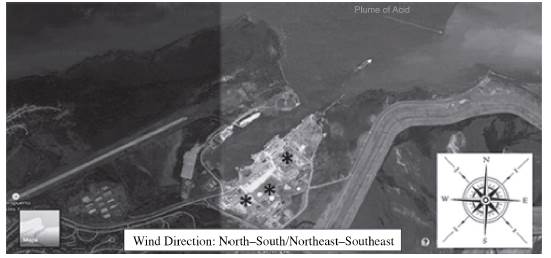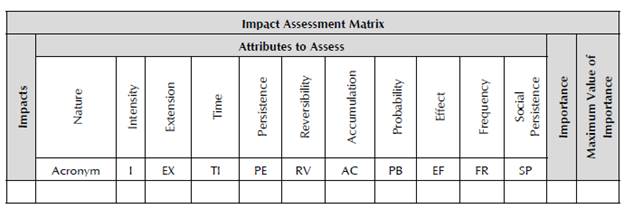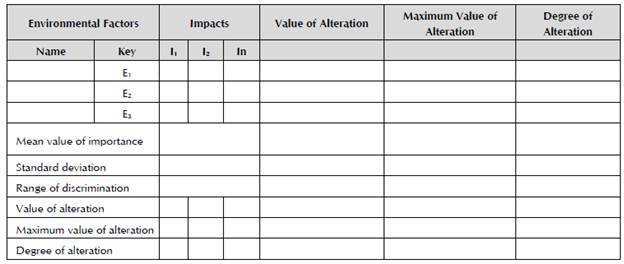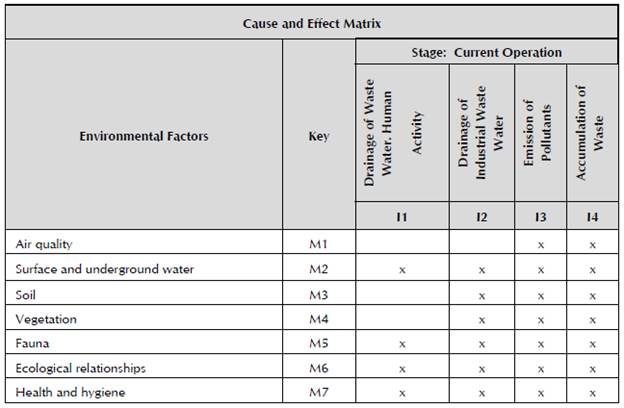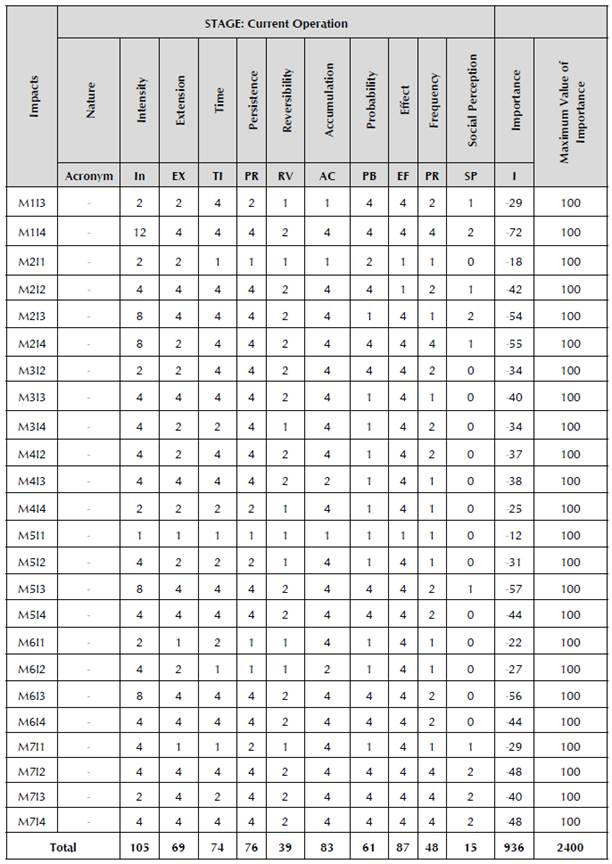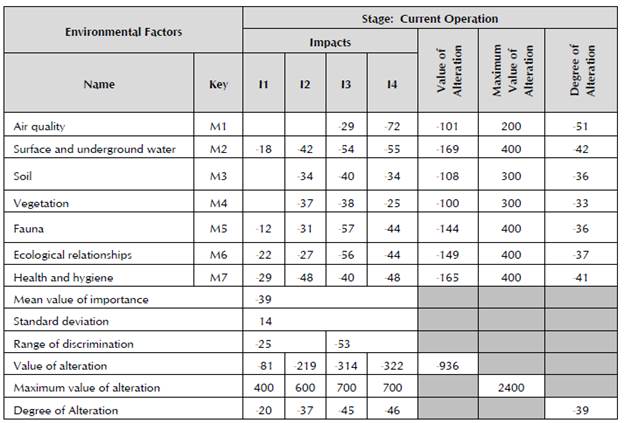Introduction
The success of maritime trade, the fishing industry and navy defense depends on the development of ports and bays, so the correct design, construction and maintenance of these coastal and marine resources is important. Maritime development usually generates local environmental problems, however, it can cause problems on a regional scale.
The impact of maritime development differs according to its location due to variations in features such as geography, hydrology, geology, ecology, industrialization, urbanization and types of shipping.
The alteration of natural waters and the construction of artificial structures may result in impacts on the existing body of water, as well as cause direct and indirect impacts on ecosystems and communities living in the ports' surrounding areas. Operations such as dredging, the generation and elimination of materials, development of beach areas, and sea and land transportation in the port may cause the release of natural and anthropogenic pollutants into the environment (Vinas et al. 2001; Guedez et al. 2003).
The Puerto Moa company is an essential part of the infrastructure of the Cubaniquel corporate group with the essential role of receiving and storing imported products or supplies for industrial use for local nickel companies, as well as exporting the already finished products of these production industries. It is worth noting the important natural, sociocultural and socioeconomic role of this institution. This is because it identifies floristic species that have a vital ecological role in the conservation of the environment, coastline and existing animal species; it generates an important number of permanent jobs in production as well as administrative areas, which results in a notable increase in the quality of life of the sector of the population that works in it; and it is an essential pillar for the country's economic growth.
Maritime activity can have a negative impact on the coastal ecosystem, not only due to the absence of treatment systems, the activity of dredging and the absence of an adequate sewage system, but also because of the combination of the environmental impacts of the entire economic activity.
The environmental impact assessment (EIA) is one of the instruments for creating environmental policy. It has a preventative nature if it is carried out from the time the project is conceived, preventing the environmental impact of the activity to develop from altering the environment (Wilkins, 2003; Garcia-Cuellar et al. 2004; Ramakrishna and Viraraghavan, 2005). The information that it provides permits an analysis of the environmental consequences of a project, which together with a social and economic assessment, defines the decisions on the project's feasibility. One of the methods to carry out the EIA is the cause and effect, or interaction matrix, which is very useful for identifying the origin of different impacts; as well as the impact assessment matrix, which allows a qualitative assessment to be obtained of the impacts' importance; and finally, the importance of impact matrix (Barker and Wood, 1999; Orozco et al. 2004; Nápoles et al. 2005).
Taking into account that port companies are responsible for loading and unloading international ships, which import and export products and supplies, and that in order to carry out their roles, they handle appreciable amounts of hydrocarbons, the present research has the objective of assessing the environmental impact resulting from port activity in Moa Bay in the Moa Municipality, Holguín Province.
Materials and Methods
Characterization of the Area of Study
The infrastructure, socioeconomic activity and movement of supplies were analyzed, as well as possible centers of contamination, in order to characterize the area of study (Figure 1). The potential impacts generated on the environment were also identified, selecting the interacting components; as well as the set of environmental elements of the physical, biological, socioeconomic and cultural environment that intervene in said interaction according to Milán (2004).
Port infrastructure: This is assessed through a company's previously characterized general organization chart (tool), and the areas of impact for the study are identified and valued according to their operation.
The company is structurally organized in four areas of regulation and control, and seven basic business units.
Socioeconomic activity and movement of supplies: These are identified by a port's group of experts, as well as the objective of the work and the roles of the units subject to assessment (such as port exploitation services, transportation services, and receipt of supplies). The previously identified and analyzed variables were: unloading of petroleum from the tankers to the berth; cleaning, drainage and repair of the storage tanks; decanting and supply of petroleum and chemical substances to consumers; unloading of ammonia from the ship to the berth; preparation of chemical solutions; unloading of coal from ship to the berth; coal mining operations; and transportation of coal to the plant for use.
Sources of contamination: These are identified through the port's group of experts and characterized by the main existing contaminating elements in them and the factors of the environment that they contaminate, reflected in the cause and effect matrix.
Impact Assessment
The qualitative assessment of the environmental impacts was determined through the use of matrices in three stages: 1. Identification of the impacts and the factors of the affected environment; 2. Impact assessment; and 3. Calculation of the importance of the impacts (Milán, 2004).
Stage 1: Identification of Impacts
To analyze the impacts, they were broken down into their different stages and activities until the identification of actions, understanding the latter as the unit capable of establishing a cause and effect relationship with its surrounding environment (Table 1). The identification of actions susceptible to generating impacts was analyzed from the general characterization of the companies, being able to determine which are the possible negative activities of the work by the individuals who work in them and who can transfer the possible generated impacts. This resulted in the identification of the affected environmental factors (land, aquatic or atmospheric) in the area of study. Then those of greater incidence were selected by direct observation of the group of experts and noted in the cause and effect matrix, in accordance with Conesa (2000).
Stage 2: Impact Assessment
The impact assessment was conducted through a detailed analysis of the interactions between the factors of the affected environment and the actions that have an impact on it, using the table of values of the attributes' impacts as methodological guide (Table 2) to conduct the qualitative assessment (Onate et al. 1998; Conesa, 2000; CICA, 2001).
Stage 3: Calculation of the Importance of Impact
The importance of impact matrix model (Table 3) was developed, which collects each one of the results calculated from the impact assessment matrix. It involves using the importance of impacts as a function directly proportional to the degree of alteration produced by an environmental impact and expressing the importance as a percentage of alteration with respect to the maximum alteration possible. The system established by Conesa (2000) was used to carry out the breakdown process and seek a greater degree of accuracy when establishing the importance of the impacts, assessing the following:
In the negative impacts, determine the mean value (Vm) and standard deviation (σ), considering as a critical value of impact (Vcr) all those with a value of importance (Vi) higher than Vm + σ. That is:
Likewise, the impacts with values of importance (Vi) lower than the mean value (Vm) minus standard deviation (σ) were considered to be irrelevant (Vir). That is:
Therefore, the range of discrimination was obtained, which does not pre-establish absolute values of importance, but is conceived as a function of the characteristics of each project that is evaluated.
Validation of the Experts' Opinions: Application of the Delphi Method
The experts' opinions were validated using the Delphi method (which dates back to 1963-1964) presented by the Rand Corporation, and particularly by Olaf Helmer and Dalkey Gordon, being the one which best adjusts to the intuitive opinion of experts on environmental issues (Linstone and Turoff, 2002). Said method was applied for selecting the group of experts, who were subjected to a self-assessment of their information and argumentation on the topic, using the required methodology.
Selection of Experts
The group of experts was selected with prior identification of the individuals (researchers on environmental topics) with competence and relevance in the researched area of knowledge based on their personal resumes. Initially, ten experts from Puerto Moa and from biotechnology and environmental study centers of the Universidad de Oriente and Instituto Superior Minero Metalúrgico of Moa were considered.
Tool
A questionnaire prepared based on the research's field of action was applied to the experts, which groups all the items in two topics: 1. Experience obtained in the research of impact assessment studies; and 2. Relevance and objectivity of the work developed as a result of their individual or collective research. To process the information collected in the questionnaire and carry out the established rounds, a computer application developed from the Delphi method was used, Version 1.0 (Oñate et al. 1998).
Procedure
The methodology to follow was established as described in Figure 2. The preliminary phase outlines the subject of study, initially conceiving the research problem, where the group of experts and the supervision of the research are decided. The exploratory phase includes the questionnaire to validate the objective of this research, while the final phase synthesizes the results of the whole process of selection, validation and assessment through agreement and consultation of the experts, subjecting the variables previously defined in the second round to assessment (Oñate et al. 1998; Linstone and Turoff, 2002).
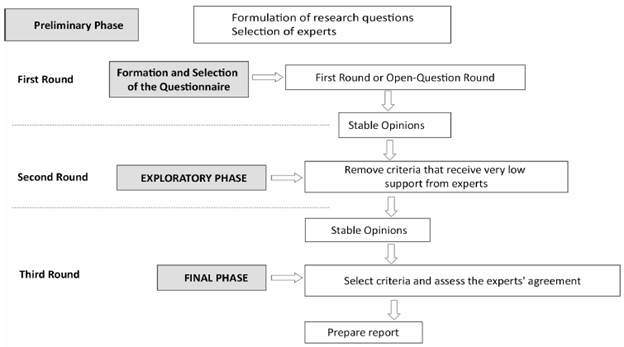
Figure 2 Representation of the methodological phases for the assessment of experts on environmental topics.
Results and Discussion
Characterization of the Area of Study
The Moa Municipality in the Holguín Province of Cuba with an area of 766.33 km2 borders to the north with the Atlantic Ocean, to the west with the municipalities of Frank País and Sagua de Tánamo, and to the east and south with the municipalities of Baracoa and Yateras, respectively. The flat area of Moa has more than 40 kilometers bathed in seawater with four bays (Moa Bay, Cañete Bay, Yaguasey Bay and Yamanigüey Bay).
Puerto Moa has facilities to receive merchandise and fuel, where maneuvers are made for the movement of supplies (such as fuel oil) through structures that transport them. It has the essential function of loading and unloading ships for international journeys for exporting nickel and importing goods including crude fuel oil, anthracite coal, and solid sulfur, which are essential for said industry. It also provides services including maneuvering, dredging, storage and distribution of raw materials (coal, ammonia, fuels and sulfur, among others), mining services and transportation of coral.
This is how maritime activity has a negative impact on the coastal ecosystem, which is related to the absence of wastewater and solid waste treatment systems, and the lack of an adequate sewage system, as well as the combination of the environmental impacts of all the economic activity carried out, and to a large extent, to the production activity and carrying capacity compared to other homologous entities of the region.
Previous studies on the Puerto Moa company correlate that different variables (waste water, industrial materials and solid waste) possibly cause already known impacts generated by the activities in the ships, such as the increase in pollutants released by re-suspension and dispersion of sediments, and introduction into the column of water; and the increase in the suspended sediments by trawling according to prevailing sea currents in the dumping area, and the effects on the existing species in the barrier reef close to the entry of the channel (García et al. 2013).
All activities generated from the port cause the alteration of the relief of the seabed in the dumping area due to the disposal of the extracted material; changes in the circulation of the marine currents as a result of the modification of the bathymetry; effects on the existent species in the barrier reef close to the entry of the channel; and alteration of some fish species due to ingestion and accumulation of heavy metals.
It is an area affected by mainly industrial, anthropic activity, which extends its influence tens of kilometers in directions governed by the wind. This causes the presence of high contents of harmful substances, such as CO2, CO, SO2, N2, CH4, H2 and particles, which even in low concentrations can affect not only the air quality, but also the soil and biota of the ecosystems, as well as the population's health.
To the west of this port company, there is a small patch of Bosque de Galería (tropical rainforest) bordering the low variant mangrove. The small area it occupies provides a measure of the alteration the forest has undergone, observing the original vegetation of individual plants such as Bucida spinosa Jenn (spiny bucida) and Calophyllum rivulare Bisse in the upper tree stratum with a height of 10 to 15 meters (García et al. 2013).
The Rhizophora mangle (L.) Mey (red mangrove) predominates in the low coastal area that surrounds to the west with a height that oscillates between four to eight meters. There are also individual plants of Laguncularia racemosa (L.) Gaertn. (Patabán) behind the sandy coastal vegetation in the direction of land.
The second variant appears in low areas with recent lateritic sediment, very poor in minerals and organic matter, formed exclusively by Rhizophora mangle L. plants, which grow up to two meters high. In the coastal area to the East, there is the tailings dam of the nickel industry. The area has undergone large alterations due to severe negative impacts. An example of this is that only three endemic species were found in Bosque de Galería, as follows: Sabal parviflora Becc., Ficus membranacea Wright and Bucida espinosa Jenn (García et al. 2013).
Apart from the indiscriminate felling of tree species, the factors that have influenced the effects of this construction include the construction of the port facilities themselves. Another factor that has had a rapid effect in recent years is the drainage of oil waste from the facilities of the oil base, which has caused the death of a large number of Bucida spinosa Jenn and Calophyllum rivulare Bisse plant individuals. In Figure 3, we can appreciate how the taproots of the mangrove barrier are covered by a considerably thick layer of hydrocarbons and industrial oil waste. In the short and long term, this causes the progressive disappearance of individual plants, the irreversible deterioration of the related coastal ecosystem and the imminent possibility of becoming an endangered and vulnerable region at risk from natural disasters. This result was obtained mainly through a detailed taxonomic inventory of the species found in the areas of study by the relevant experts and through the analysis and comparison of the historical records of the place.
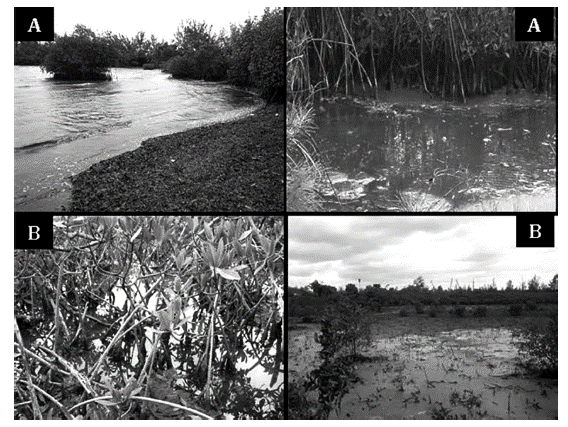
Figure 3 Images of areas affected by oil hydrocarbons from the companies established in the port. Mangrove (A). Marsh (B).
The fauna has still not been studied in depth, but invertebrates are observed, including insects, arachnids, crustaceans and myriapods. The problem also applies to the group of land molluscs, which have been studied little (García et al. 2013).
In the coastal area of the port, the mangroves do not present a very positive situation, due to the contamination of the soil, which has caused the alteration of its physiochemical properties and erosion. Alteration from flooding and salinity lead to defoliation, breakdown of the habitat, variation of the floristic composition of the mangrove, and soil compaction. All of the above has led to a decrease in the associated fauna, alteration of surface runoff, loss of mangrove soil, a decrease in the scenic value of the landscape, mortality of the mangrove, and proliferation of undesirable species (Atucha, 2009).
The degradation of the environment is mainly due to the lack of awareness on the values of the area and impacts on the resources, as well as the ways of preventing or mitigating the damages; to emissions of smoke and gas from the combustion of hydrocarbons by nearby industries; and to the absence of a treatment system for liquid and solid waste. This leads to the presence of these items throughout the coastline in the mangrove ecosystems (Figure 3). This situation can be observed throughout the coastline and in the mangrove ecosystem with the appearance of different industrial products (such as hydrocarbons) and waste from human activity (Figure 3). The latter to a lesser degree, which would be resolved if there was an instrument in the company that regulated the final disposal of this waste.
Evaluation of the Environmental Impact through the Analysis of the Matrices
The environmental impacts were obtained by analyzing the interaction between the components from the companies settled in Puerto Moa and the environmental factors of their surroundings. The affected factors of the environment and the activities that generate impacts with the execution of the project were identified.
In the current conditions of operation in the EIA, the cause and effect matrix (Table 4) presents two entries with seven environmental attributes that can be affected, and four entries that can have an impact on the environment and health. Analyzing the 28 possible interactions obtained in the cause and effect matrix, 24 attributes were found related to their respective activities of impact. It was identified that the air quality is determined by the activities of emission of pollutants and accumulation of waste. In turn, the surface and underground waters are affected by the drainage of waste water from human activity, drainage of industrial water and liquids, emission of pollutants and accumulation of waste.
The soil and vegetation factors are affected by all the activities of impact except for the drainage of waste water from human activity. Fauna, ecological relationships and health and hygiene intersect with all the activities of impact in the matrix (Table 4).
In a second stage, the impact assessment matrix was prepared, which permitted a qualitative assessment on the importance of the present impacts, intercepting the two pieces of information obtained from the cause and effect matrix. This was done in order to indicate which environmental changes are caused from the initial state of the environment during the execution of the project, as well as during its exploitation, facilitating an assessment of their importance.
The impact assessment matrix (Table 5) shows 24 negative impacts as a result of the analysis from the comparison of the data of the cause and effect matrix with the 11 characteristics of the matrix in question. This means that as well as being harmful, they reduce the quality of the analyzed factors. Therefore, three irrelevant results below 25 are shown, a value established in the methodology by Conesa (2000) and Milán (2004), corresponding to M2I1, M5I1 and M6I1 for 13% of the total (García et al. 2013). In the case of the moderate results, there are 16 values between 25 and 50, which amount to 67% of the total. The severe resuits between 50 and 75 show five attributes affected corresponding to M1I4, M2I3, M2I4, M5I3 and M6I3, amounting to 21%.
As shown in Table 5, regarding the air quality factor, the impact of the emission of pollutants was moderate, essentially determined by the attributes of intensity, time, effect and probability. However, for this same factor, the impact of accumulation of waste was severe, essentially determined by all the attributes except for reversibility and frequency, which presented values of 2; 12 being the highest for the intensity attribute. The surface and underground water factor was irrelevant for the effect of drainage of water from human activity and moderate for the drainage of industrial liquids and waters, having a severe effect on the impacts of emission of pollutants and accumulation of waste, respectively, where the attributes of greatest influence were intensity, extension and time (Table 2).
In all the analyzed cases, the soil factor was moderate with respect to the impacts, without any significant difference between them. The attributes of greatest influence were intensity, extension, time and effect. The same occurs with the results shown by the vegetation factor, where the effects of the impacts are also moderate (Table 5).
In the specific case of the factors of fauna, ecological relationships, health and hygiene, they are affected by each one of the identified impacts, but show differences, some of which are significant in terms of the degree of importance of the effect. An example of this is shown by the fauna factor with respect to the emission of pollutants having a severe effect compared to the other impacts, which are moderate, one having an irrelevant value. The attributes that have the most influence on the case of the greatest value (severe) are intensity, extension, time, reversibility, accumulation and probability. The same occurs with the ecological relationships factor, which shows an impact with a severe effect and the influence of attributes such as extension, time, reversibility, accumulation and importance. There is also one irrelevant effect and two moderate effects (Table 5).
For the health and hygiene factor, it is worth highlighting that all the operating factors have a moderate effect, but that is borderline with a severe effect. This means that this is a factor susceptible to any variation in negative effects, where attributes with great frequency of appearance are shown, such as extension, time and reversibility.
From the analysis of the cause and effect and impact assessment matrices (Table 4 and Table 5), it is derived that the impacts that have an effect and the damaged environmental factors are also included in the importance of impact matrix. The latter reveals that there are essentially two environmental factors that are greatly affected. First, there is the environment factor: surface and underground water, with a value of alteration of 169, where the maximum value of alteration was 400 and the degree of alteration of -42 was the most affected. It is worth highlighting that Impact I4 (accumulation of waste) has the greatest influence on this factor with a -55 value of importance. The second environmental factor that showed high rates of effect was health and hygiene, with a value of alteration of 165, a maximum value of alteration of 400, and a degree of alteration of -41, where Impact I4 with Impact I2 (drainage of industrial waste) again exercise a negative influence of -48 of importance.
In turn, the matrix of importance (Table 6) also shows two environmental impacts with high values of alteration. Impact 3, identified as emission of pollutants, shows a value of alteration of 314, with the maximum value of alteration of 700 and a degree of alteration of -45. Impact 14, identified as the accumulation of waste, shows the most elevated value of alteration that it can express toward the environmental factors, reaching a value of 322, also with its maximum value of alteration of 700 and a degree of alteration of -46.
Results of the Delphi Method to Validate the Research
On many occasions, mathematical techniques and statistics are not capable of revealing the essence of the objects and phenomena that are studied, because they are multivariate and very complex. Therefore, methods have been developed from the experience and knowledge of a group of people considered to be experts on the addressed topic, so that they can offer conclusive assessments of a problem in question and make recommendations with respect to its essential times with maximum competence.
The analysis of the impact generated by handling hydrocarbons and other supplies in the companies settled in Puerto Moa was conducted by a group of experts. To do this, surveys were conducted that provided qualitative opinions in the first round, and quantitative opinions in the second and third rounds. This permitted a unit of opinions on the variables that have a greater influence on the selection of the kind of rehabilitation, following the diagram established for this kind of analysis (Figure 2).
In the first open-ended question round, the eight suggested variables were analyzed and accepted. This provided an assessment of the experts' preparation to undertake this kind of study. A questionnaire was used that demonstrates the experts' preparation in terms of environmental impact assessments; experience and in-depth knowledge of the topic, as well as the existing methods, and the main tasks; and the knowledge of the existence or not of methodologies that permit an adequate study of the environmental impact assessment. This ends with a report on the impact assessment with proposals of measures that ensure the mitigation of the detected impacts.
The results of the surveys demonstrated the stability of the experts' opinions. The eight variables were accepted and they went to the next round.
The second phase permitted the relative frequency and the average acceptability to be determined, which led to selecting the final variables. A repetition of seven was used, using the Kcomp value of each expert, which allowed the frequencies to be weighted from the assessment of all the experts of the previous round. No score was ignored, because the lowest value of relative frequency was 7.6, compared to the maximum rating of 10 obtained from the eight variables, with an excellent average acceptability.
The eight previously defined variables were subject to assessment, and as a selection criterion, a scale of 3,000-9,000 was taken in descending order with 3,000 being the lowest incidence and 9,000 being the highest incidence.
The degree of agreement between experts was determined from the assessments obtained using Kendall's (K's) coefficient, with a value that oscillates between 0 and 1. It is considered that when K is greater than 0.7, there is high agreement between the experts, and when K is less than 0.4, there is no agreement (Linstone and Turoff, 2002).
Therefore, in the selection of the main variables that influence the assessment of the expert's opinions, Kendall's coefficient is 0.95, confirming that there is agreement between the experts' opinions.
Conclusions
The data analysis methodology through the group of experts shows positive concordance related to the resuits issued for their validation. Therefore, the analyzed environmental, soil and human (health and hygiene) factors are the ones most vulnerable to the socioeconomic activity carried out in the area of study. They showed an elevated exposure to hydrocarbons and industrial waste, as a result of the lack of a treatment system, the absence of environmental management tools and policies, and work on good practices, which pave the way for proper management and relations with the existing environmental factors. The results collected by the importance of impact matrix for the aforementioned factors displayed significant values of importance with respect to the other environmental factors and the great vulnerability of the identified impacts. The study suggests preparing a portfolio of projects for improvement, and organizing adequate environmental management for the Puerto Moa company, as well as characterizing the soil contaminated with hydrocarbons for its possible improvement using biotechnological treatment tools.











 texto em
texto em 

